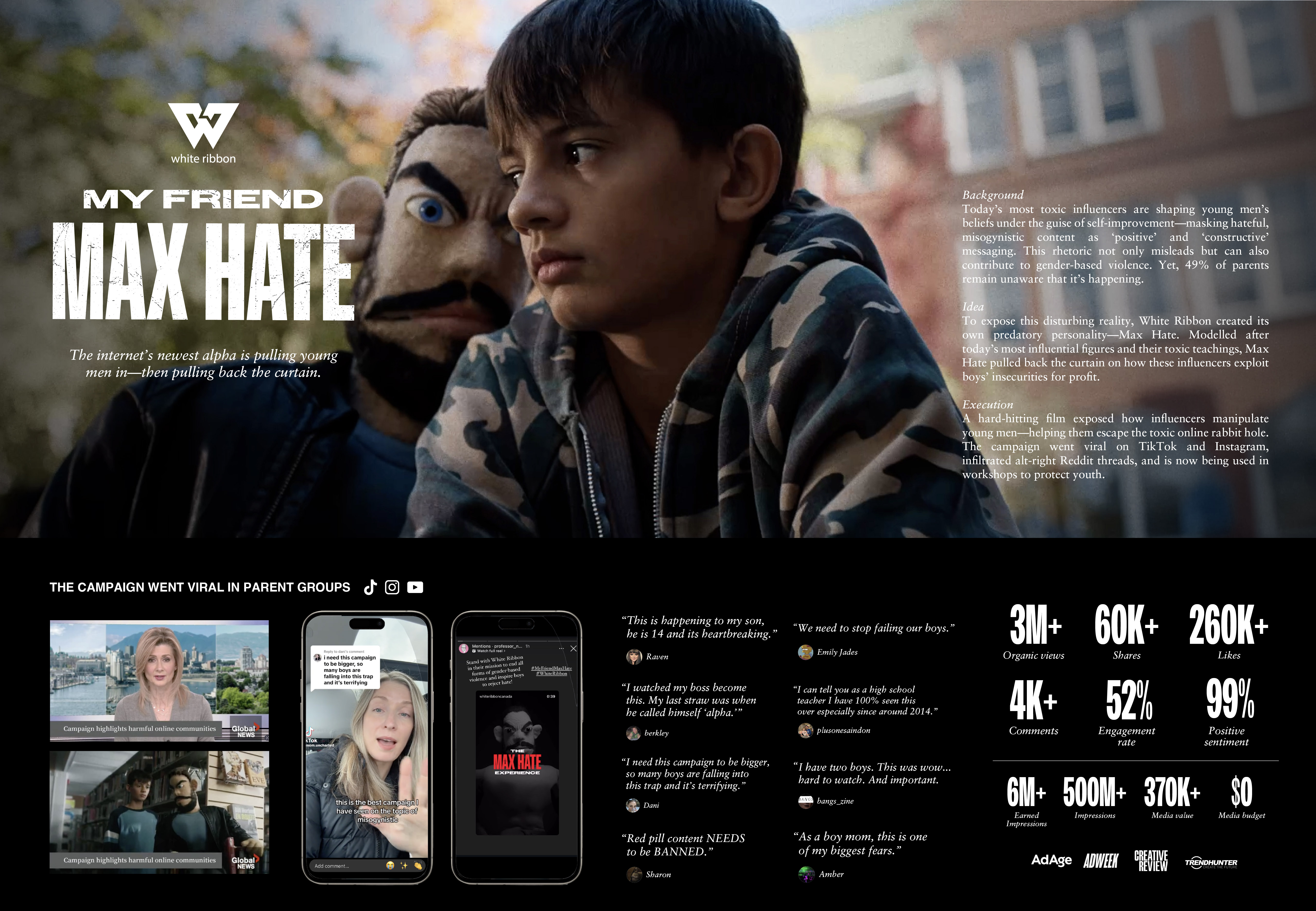
2025 Winner

PS Grand Prix
GoldCause/Public Service
SilverContent Strategy
SilverSocial/Conversational Strategy
BronzeDEI Strategy
BronzeCreative Catalyst
White Ribbon
"My Friend, Max Hate"
Bensimon Byrne
"My Friend, Max Hate"
Bensimon Byrne
CASE SUMMARY
White Ribbon has spent over 30 years working to engage men and boys in ending gender-based violence. In 2025, the brand wanted to focus the campaign on the alarming rise of misogyny being spread online by male influencers in the manosphere — a term that, despite its growing cultural relevance, remains unfamiliar to 83% of Canadians, including 82% of parents with boys.“My Friend, Max Hate” came at a particularly urgent time. As politics in Western countries swing further to the right, online hate — especially misogynistic, racist content — has become increasingly normalized in
public discourse.
Young boys, who are already vulnerable due to a lack of education on healthy relationships and growing disconnection from real-world communities, are being targeted directly by influencers who package hate
as empowerment.
The strategy was built around a critical cultural insight: boys are not seeking guidance from parents or educators — they’re turning to online influencers. They’re being drawn in by figures who promise confidence and success — only to be fed a steady diet of misogyny and hate.
They didn’t want to just warn parents about the problem; they wanted to infiltrate the ecosystem itself, ensuring the message wasn’t just seen by adults, but by boys themselves, sparking conversations and helping families recognize the signs before it’s too late.
To do this, they’d need to develop compelling content that spoke to an increasingly alienated segment of young men, while educating and engaging parents to the risk these hateful influencers pose.
Misogynistic influencers have become the loudest, most trusted voice in the room for a growing number of alienated, isolated boys.
The one-line idea was to create a character who exposes the threat and empty promises of these misogynistic influencers.
They exposed the manosphere’s toxic tactics by using its own playbook — creating their own influencer, Max Hate, in the style of a puppet built on different manosphere personalities.
Instead of spreading misogyny, Max exposed how these influencers operate, showing families and young men exactly how vulnerable boys are manipulated into hate. The film plays like a psychological thriller, using storytelling techniques from popular online content that boys are already consuming. Max Hate was designed to feel real — they launched as a TikTok personality, living in the same algorithmic feeds that fuel the manosphere’s influence.
This approach transcended the original challenge of raising awareness by embedding the message directly into the culture where harm happens. By surprising audiences with a puppet who speaks like a manosphere influencer — but exposes the truth instead — the work captivated attention, sparked debate, and ultimately opened a critical conversation about masculinity, manipulation, and media literacy in the digital age.
Every element of the campaign was crafted to feel real and immersive, from the unsettling design of Max himself to the naturalistic performances and tension-building cinematography. The film was designed to work both as a standalone story and as native content on social — meeting boys in the same feeds where toxic influencers thrive.
To reach the audience directly, Max Hate was launched as his own TikTok personality, blending into real content streams. This was supported by targeted social posts that spoke directly to boys and young men, using the same provocative tone and style that the manosphere uses to capture attention.
“My Friend, Max Hate” exceeded all objectives, sparking national conversation and driving real cultural impact. With 3 million views across TikTok, Instagram, and YouTube, the content generated 260,000 likes, 60,000 shares, and an engagement rate of 52% — proof that the message resonated.
The campaign also triggered over 4,000 comments, where parents and educators actively defended the work against manosphere trolls, demonstrating how powerfully the message was embraced. Most importantly, 99% positive sentiment showed the work not only captured attention but struck the right chord.
In March of 2025, “My Friend, Max Hate” received a second push with the release of Adolescence, an acclaimed Netflix drama which drew attention to the threat of online misogyny and the incel community, proving the timeliness of the campaign and having it picked up yet again by national news outlets.
The campaign’s impact extends into classrooms — now being used in schools across Canada to help educate students about online radicalization, toxic masculinity, and media literacy. With over $750K in earned media value on a $0 media budget, “My Friend Max Hate” proves that when parents, educators, and allies come together, we can give boys the tools to question harmful narratives before they take hold.
Credits
Chief Creative Officer Joseph BonniciExecutive Creative Director: Debbie Chan
Creative Director: David Mueller
Associate Creative Director: Ana Segurajauregui Sanchez
Art Director: Zoë Gray
Senior Strategist: Pat Martini
Writer: Nate Houseley
Senior Business Lead: Pat Martini
Program Director: Oliver Glover
Agency Producer: Michelle Pilling
Executive Producer: Amanda Morrison
Director: Angie Bird
Director of Photography: Mat Barkley
Line Producer: Kailey Shanque
Producer: Sam McLaren
Editor: Michelle Czuker
Editor Assistant: Matt Blakely
Producer: Andrew Tavares
Editor: Saba Zahir
Editor: David Whiteson
Producer: Julia Vasiliev
Director: Jared Kuemper
Engineer: Marcel Hidalgo
Engineer: Tyler Young
For submission inquiries, please contact Clare O'Brien at cobrien@brunico.com.
For partnership inquiries, please contact Neil Ewen at newen@brunico.com.
For partnership inquiries, please contact Neil Ewen at newen@brunico.com.